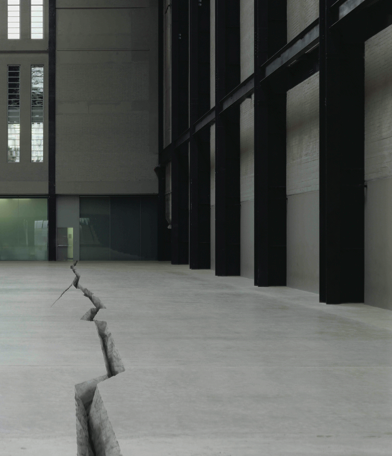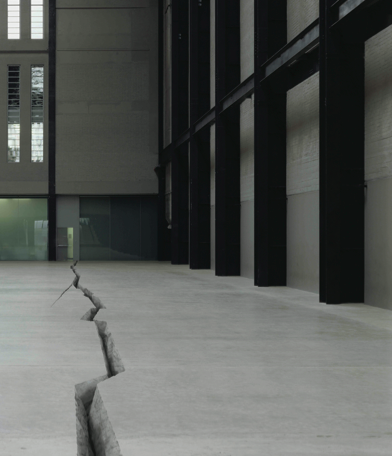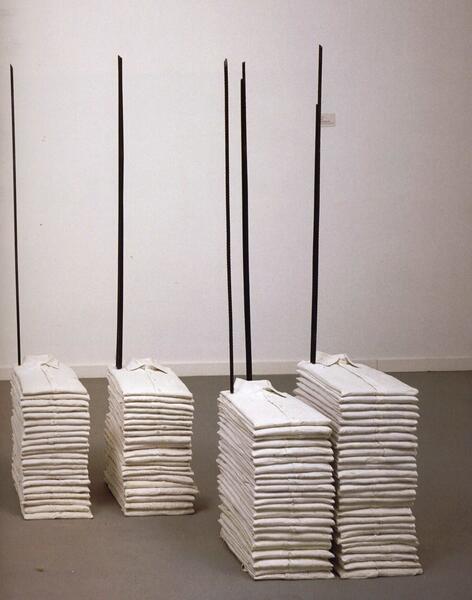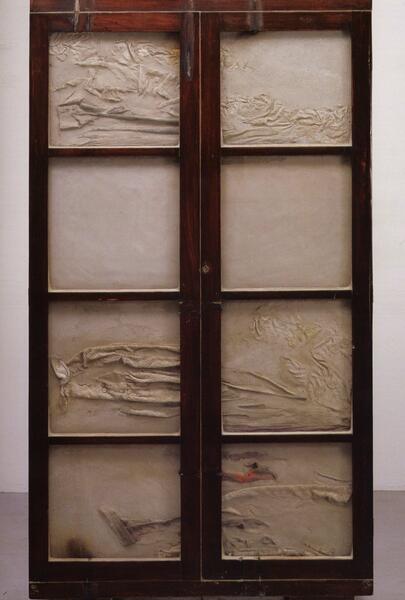Doris Salcedo
Non-resolution as Possibility
Aprofound humanist concern underlies the work of Colombian artist Doris Salcedo. Shibboleth, her most recent work exhibited at the Turbine Hall in London between October 2007 and April 2008, reiterates this concern. As the artist states, this work makes reference to the deep divisions that prevail in the present-day world. Although Shibboleth’s thematic content apparently differs from that of previous works, it is motivated by questions that are similar to those the artist has posed throughout her career: How can a human being discriminate and exclude, torment, or even permanently incapacitate another human being? How can we, human beings, perform actions that may, from a humanist perspective, be considered fundamentally inhuman?

Just like other works by this artist, Shibboleth also elicits questions from the viewers: What makes Salcedo injure, pierce, capture objects; obstruct, incarcerate, blind and crack spaces? What makes her simultaneously “cure”, preserve and conserve these objects; protect and liberate spaces?
Where do the questions that motivate the artist’s activity and those that the works suggest to the viewers, converge? The works do not offer answers, but they afford the opportunity and the chance to reflect, to gain perspective and inquire into the apparent contradictions and contrasts included therein. Shibboleth contains elucidative keys insofar as it shares and amplifies the contradictions and contrasts characteristic of previous works; it offers the viewer, for instance, the possibility to approach it as an image and/or as a personal experience, at the macro and micro levels. On entering the Turbine Hall, visitors may visually appreciate the irregular crack that cuts across the floor of the building; as they walk about, they are physically compelled to take it into account, either to step over it or to avoid an accident. The macro-vision/experience of the work may be complemented by a more detailed perception of the space within the crevice and of the wire mesh that covers the walls that form it. These offer contrasting readings: the crack suggests both opening and closing processes; the wire mesh may suggest containment aimed at preventing crack growth, or limitation to keep some alien element from penetrating the protected wall. There is also a third option: that the crack and the wire mesh imply both processes simultaneously, that this is, precisely, their reality: construction/destruction, inclusion/exclusion, healing/injury.
This third alternative, intrinsic to the fundamental state of non- resolution of the work, has been present ever since Salcedo began her artistic career in the early 1980s. By contrast with what may be observed in her most recent works, certain objects played a leading role at that time. They were deliberately sought by Salcedo with the purpose of manipulating them and relating them to other objects in such a way that they might be transformed into metaphors. Examples of this are her works titled 1987, 1988 and 1989. Those transformed objects contain evidences of the artist’s simultaneously constructive and destructive gestures (when disassembling and later juxtaposing pieces, piercing and sewing them, for instance,), and of situations in which protection and oppression, care and aggression coexist. As she became more directly involved with the political conflict that prevailed in Colombia, the objects employed presented different characteristics and connotations. At the same time, the exhibition space became more relevant and acquired a more significant role. The works dating from 1990 evince this change. In them, Salcedo utilized pieces of clothing (shirts) and domestic objects (folding cots), which she distributed strategically in the gallery space as an allusion to a massacre that took place in northwestern Colombia. These objects took on the role of substitutes for the victims, for people related to them and for witnesses of their fate; the space offered spectators the possibility to through the work and at the same time, recreate the physical and emotional environment in which the mentioned event had taken place. In works dating from the mid-1990s, such as the series of La Casa Viuda (1992-94), the installation featured at The Carnegie International (1995), and Trace (1999), Liverpool Biennial of Contemporary Art, and Unland (1998), presented at SITE Sante Fe, the interaction between the objects, the pieces of clothing and the space became even more closely imbricated. All these works generate the impression that the situations described are unfinished, incomplete: neither the objects nor the space undergo total destruction, yet none of them recovers its functionality; they do not cease to exist, but they cannot lead a “normal” existence, either.
Since the end of the 1990s and the year 2000, Salcedo ́s works have assumed new dimensions. In some cases, the objects have tended to disappear, assigning the leading role in the work exclusively to space, as was the case in Abyss – executed for the Turin Triennial in 2005 – in which Salcedo created four brick walls in a 9 x 15 meter gallery. The walls extended downward from the existing eighteenth-century domed brick ceiling and almost entirely covered the windows, thus severely limiting the light in the gallery. On the other hand, the ambivalent use of a wire mesh fence such as the one employed at the Tate also showed a change in the perception of space, as could be appreciated in Neither, a work executed in London (2004) and permanently installed in the Inhotim Centro de Arte Contemporânea, in Brazil, as of the current year. Due to the intermittent appearance and disappearance of the wire mesh on the walls and the gallery space which surrounded the spectator, these became metaphors for what human beings can do: confine or liberate, protect or suppress. The same actions that Salcedo herself projects onto the materials, walls, objects and space in general.
The analysis of the profound conducting threads in the work of this artist makes it possible to recognize a point where the questions posed at the beginning of this article converge: the fundamental reality one becomes aware of on interacting with her works. The non-resolution that characterizes them is equivalent to the non- resolution associated to the human being’s reality. A reality in which the human and the inhuman coexist intrinsically; in which the ability to construct and destroy, to include and exclude, to care for and attack are intimately entwined. The artist’s gestures, evidenced in her works, are an allusion to the contradictory actions that the human being is capable of. The humanist concern that pervades Salcedo ́s oeuvre implies the need to humanize the inhuman and acknowledge it as an inherent and inextricable dimension of the human being. The works encourage a resolution; they pose a challenge to confront the inhuman not as a foreign and alien dimension but as an inherent and specific one. Both the human and the inhuman are intrinsic possibilities; they constitute a potential inherent in the human being. The non-resolution of the works forces us to confront ourselves in our own possibility.
Profile :
Born in Bogotá, Colombia, in 1958. After finishing her studies at the Universidad de Bogotá, she completed her training at New York University, and later returned to her native city, where she currently lives and works. Her most relevant solo shows include: Shibboleth, Turbine Hall, Tate Modern, London (2007); Neither, White Cube, London (2004); Doris Salcedo, Camden Arts Centre, London (2001); Doris Salcedo, Tenebrae: November 7, 1985, Alexander and Bonin, New York (2000); Doris Salcedo: Unland, Tate Gallery, London (1999); Unland/ Doris Salcedo: New Work, San Francisco Museum of Modern Art (1998); Unland/Doris Salcedo, The New Museum of Contemporary Art, New York and SITE Santa Fe and Doris Salcedo, Le Creux de L’Enfer, Thiers (France), curated by Laurence Gateaux (1996).
She has participated in numerous group shows, among them, Wrestle, Hessel Museum of Art, Annandale-on- Hudson, NY, Portrait/Embodiment/Homage, The Pulitzer Foundation for the Arts, St. Louis, The 80s: A Topology, Museu Serralves, Porto (2006); Abyss - T1 Triennial of Contemporary Art, Castello di Rivoli, Turin (2005); Farsites/Sitios Distantes, San Diego Museum of Art; Centro Cultural Tijuana CECUT, 8th International Istanbul Biennial (2003); Documenta 11, Kassel (2002); Trace, The Liverpool Biennial of Contemporary Art (1999); Carnegie International 1995, Carnegie Museum, Pittsburgh (1995); About Place: Recent Art of the Americas, Art Institute of Chicago (1995) and Cocido y Crudo, Museo Nacional Centro de Arte Reina Sofía, Madrid (1994).







